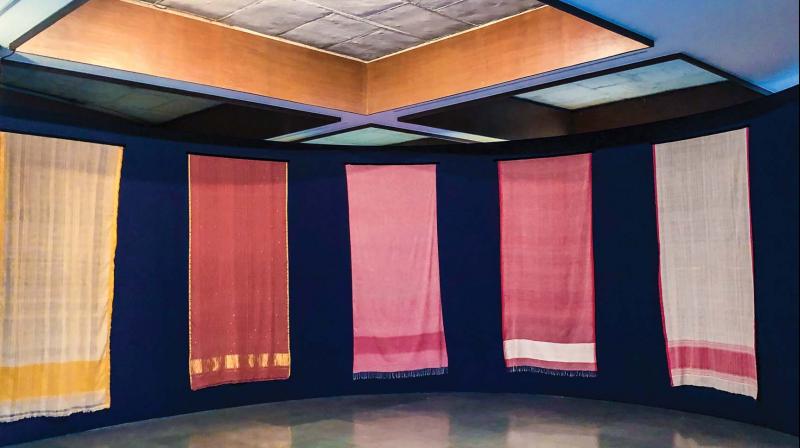It’s a ‘material’ world: Unraveling the saree story
The collection lay forgotten for 15 years after that, until a large number of the sarees were acquired by the Bengaluru-based Registry of Sarees.

When Martand Singh, the renowned textile expert, decided to commission a range of handspun and handwoven fabrics in the year 2000, it was to reflect on where the form stood, at the turn of the millennium. By the time the exhibition rolled around a couple of years later, in 2002, Singh had a collection of 108 sarees, designed in Bengal and Andhra Pradesh, made with fabrics gathered across nine states. That exhibition, Khadi – The Fabric of Freedom, led by textile experts Rahul Jain, Rta Kapur Chishti and designer Rakesh Thakur, travelled to Delhi, Mumbai, Kolkata and Bengaluru.
The collection lay forgotten for 15 years after that, until a large number of the sarees were acquired by the Bengaluru-based Registry of Sarees. 51 sarees out of the 108 are part of Meanings, Metaphor - Handspun and Handwoven in the 21st Century, a week-long exhibition at the Bangalore International Centre, the first major show to happen at the city’s new cultural centre. The Registry of Sarees, which is now home to a large part of the Khadi – Fabric of Freedom collection, was founded in 2016 by, Ahalya Matthan, who led the tremendous #100sareepact on social media, with thousands of women re-discovering their love for the saree. That’s when Matthan and independent curator Mayank Mansingh Kaul, a protege of Martand Singh, realised the power of social media. Still, it wasn’t enough. The knowledge base was still small and it wasn’t long before everybody became an expert. But Ally soon found herself tiring of the rigmarole - of posting photographs, of compliments. There had to be more to it than that.
“I’m one of those ‘aunties’ in saas-bahu serials except my focus is textiles, not people,” she chuckles, settling down on a bench at the Bangalore International Centre. “As Indians, we grow surrounded by beautiful textiles - we al have mothers and grandmothers with lovely sarees. But we rarely go beyond the personal sentiment, we rarely think of the product. A saree has a weaver who has put his imagination, skill and design skill into it... the saree goes through his story before we appropriate it and make it ours.”
Travelling the country to meet weavers, Matthan found reality very different from the urban narrative. The urban millenial has a soft corner for a sad story and the so-called dying traditions of weaving are a favourite. Matthan found, to her surprise, a thriving culture of spinning and weaving - “It may not be practiced as widely today as it was before but it’s there. It’s respected as a tradition and as an art.” It’s the philosophy that drives Registry of Sarees too - the enabling of design, curatorial and publishing projects involving handmade Indian textiles.
Inside the building itself, the production team puts the finishing touches on the exhibition. The ground floor is a sea of blue, a big leap, really, from the swank, hi-tech, modernist space, but the effect is oddly calming. Upstairs, reds and yellows dominate the second floor, with the whites occupying the gallery space above. Some 150 weavers are being brought in to attend the exhibition, says Mayank. There will be talks and workshops too and as Matthan explains, “the people we chose are the success stories. Those are the ones we need to hear.”
The word ‘khadi’ has many connotations, several of them political. The word khadi is taken from ‘khadar’, the pit loom, Mayank explains. “Today, it means a range of products that come from a relatively rural production base, it could be anything, from soap to food. Gandhi talked about spinning local cotton but the textile khadi is now a very expensive product. We wanted to move away from the loaded symbolism of the word and we began with the title.” Meanings, Metaphor - Handspun and Handwoven in the 21st Century, as the exhibition is now called, was a great success at the Lakshmi Mills in Coimbatore. “The idea is to try and reclaim the aspect of handspinning. The symbolism of Khadi has remained but the product has changed. We want to return to its essence - handspun, handwoven fabric, to the material,” says Mayank.
They do shy away from elaborate narratives, though -this is a ‘feeling’ space. “I’m hoping to bring out a more visceral response to the fabric, rather than an intellectual one.” A quote by Martand Singh, in yellow lettering up on one wall, sums it up: ‘The woven journey has come full circle. The older I grow, the less I know, the more I feel. ‘
What: Meanings, Metaphor - Handspun and Handwoven in the 21st Century
When: March 30 to April 6
Where: Bangalore International Centre, Domlur

